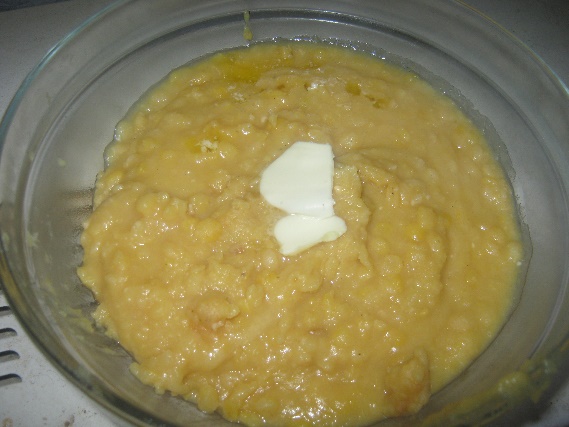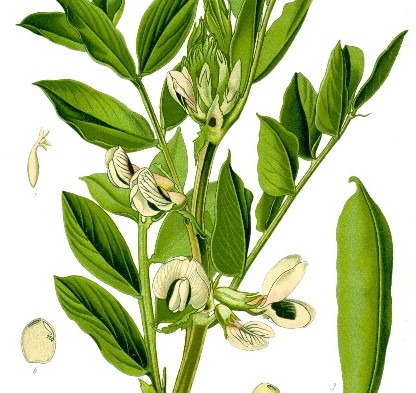Sunday 10 March 2024
The Bean-Bellies of Leicestershire – an Eco-History of a Name
LAHS Trustee and Committee Member, Elizabeth Tingle explores the now forgotten importance of the humble bean as a widespread staple food crop in Leicestershire across the centuries.
In William Burton’s The Description of Leicestershire of 1622, he commented,
‘The whole shire … yeeldeth great aboundance of Peas and Beans, more than any other Country, insomuch, that there is an olde by-word of the same, commonly knowne to all men, Leicestershire bean-belly’.
The parish of Barton-in-the-Beans was particularly linked to the crop.[1]The association of Leicestershire people with beans was clearly of long standing by this date and would persist into the nineteenth century. A contributor to Magna Britannia of 1820 repeated the saying, ‘Shake a Leicestershire man by the collar and you may hear the beans rattle in his belly’, and Arthur Benoni Evans, in Leicestershire Words, Phrases and Proverbs (1881), wrote ‘Bean-belly: an epithet of Leicestershire’.[2] But how did this ‘bean-belly’ description arise? The answer lies in the open fields of Leicestershire’s champion country.
The beans which filled Leicestershire bellies were ‘broad’ beans, Vicia faba, which come in a wide range of cultivated varieties. Beans were grown as a food plant from the ninth millennium BCE, starting in the Near East. They arrived in the British Isles in the Neolithic period, and there is a small amount of archaeological evidence for them from southern England. The ‘Celtic’ bean seems to have been introduced in the early Bronze Age, becoming more common and widespread over time; by the Iron Age it was frequent across central and southern England.[3] In Leicestershire, excavation of a middle Iron Age site at Wanlip recorded peas and/or beans in several contexts including from around a house site.[4] New varieties of beans came with the Romans and in the Middle Ages, and they were a commonly consumed legume, often in association with peas, a word which was often used for both crops.

Widespread cultivation of beans and peas in Leicestershire seems to have begun in the thirteenth century. For example, in Ingarsby in 1305, a jury found that Richard, rector of Hungarton, had taken corn, barley, oats, beans and peas belonging to Ware priory, and awarded it 20 marks damages.[5] By this date, much of the county’s arable agriculture was organised into open fields, organised communally, on a three-year rotation of crops. The typical rotation was that in each field, or sub-division of a field known as a furlong or wong, winter-sown wheats were grown in year A, pea/beans or oats in year B, and year C would see the land left fallow. On 25 holdings of the estates of Leicester Abbey recorded in 1363, the proportion of ‘peas’ sown (probably included beans) was 17 percent of the cultivated area; this increased to 30 percent by 1400 and thereafter.[6]

By 1500, perhaps 35-40 percent of the sown area of Leicestershire was given over to beans and/or peas. When John Leland travelled through the county in the late 1530s, he noted that ‘Betwixt Trent ripe and Melton many benes and person, as yt is communely thorough all Leyrecestreshir.’[7] G.W. Hoskins’ study of probate inventories of sixteenth-century Leicestershire shows that in the 1520s and 1530s, peas/beans made up 42.8 percent of crops grown, with barley at 36.8 percent and wheat at 12.9 percent. By 1588, the proportion of peas/beans had risen to 45.9 percent, with barley the same but wheat in decline.[8] As an example, Hoskins describes the property of William Copeland of Queniborough, who died in 1529; he had 36 acres of arable of which 24 was under cultivation at the time of his death, 6 acres under winter corn, 10 acres of peas/beans and 8 acres of barley.[9] By the seventeenth century, peas/beans were the most frequently grown crop, followed by barley, with wheat in third place.

Beans and peas had many uses. Some varieties, perhaps grown in gardens, were harvested ‘green’ and used as a vegetable. Most were grown in the fields and harvested dry and were used as a pulse for human consumption; pease bread and pease pottage were staples, and for the more affluent, peas/beans were cooked with bacon. In fact, Leicestershire folk may have eaten little wheaten bread in this period; the astronomer William Lilly, originally from Diseworth, wrote that when we went to London as a young man, ‘I saw and eat good white bread, contrary to our diet in Leicestershire.’[10]
Above all, the bean was fodder for livestock; sheep in particular were fed the plant as well as the seed, and there were large flocks in the late medieval and early modern periods. The cultivation of beans and peas was well suited to the heavy clays and lias of Leicestershire. Seeds were usually broad-cast sown in February, either on once-ploughed land which was then harrowed, or on stubble fields and then ploughed in. They were reaped by sickle when dry, in September, and the bean separated from the plant by threshing.
From the second half of the eighteenth century, bean cultivation declined. Parliamentary enclosure led to changes in land use, essentially an increase in pasture and a reduction in arable. On the sown area, turnips and cabbages replaced beans as fodder crops. Even pigs were now fed on barley meal with some potatoes. When William Pitt surveyed the agriculture of Leicestershire and Rutland in 1807-8, he noted that under the previous common field system of culture, there were probably 40,000 acres under bean annually; by the time of his visit, this had reduced to around 10,000 acres.[11] Decline continued across the nineteenth century.
But fast-forward to 2024, and beans are undergoing a revival. A farmer in Lincolnshire recently made the news for growing domestic baked beans (an American haricot bean, Phaseolus vulgaris).[12] Of course, beans never disappeared from Leicestershire. For example, on the present-day 850-hectare farm of A.H. Oliver and son near Market Bosworth, 200 hectares are given over to winter beans.[13] Beans have even become a cultural icon. In the summer of 2023, artist Sean Roy Parker saluted the ‘Bean Bellies’ of Leicestershire with an installation called ‘The Beans’ created at Stanford Hall. It was a living bean culture, exploring food growing, permaculture and human well-being.[14] As the seventeenth-century poet William King wrote, so it remains true, that ‘Leicestershire beans and bacon’ remain the ‘food of kings!’[15]
Elizabeth Tingle
[1]William Burton, The Description of Leicestershire Containing Matters of Antiquity, Historye, Armorye and Genealogy (London, 1622).
[2]Magna Britannia cited in J.B. Firth, Highways and Byways in Leicestershire (London, 1926), p. 422;Arthur Benoni Evans, in Leicestershire Words, Phrases and Proverbs(London, 1881)
[3]Edward R. Treasure & Mike J. Church, ‘Can't find a pulse? Celtic bean (Vicia faba L.) in British prehistory’, Environmental Archaeology 22/2 (2016), pp. 113-127.
[4] Matthew Beamish, ‘A Middle Iron Age Site at Wanlip, Leicestershire,’ TLAHS 72 (1998), pp. 76-82.
[5] Cited in John Britton, A Topographical and Historical Description of the County of Leicester (1813), p. 81.
[6] Cited in The Victoria County History of Leicestershire, vol. II, p. 161.
[7]John Leland, The Itinerary of John Leland, in or about the Years 1535-1543, ed. Lucy Toulmin Smith, (London, 1964), Vol. IV, part VII, p. 19.
[8]G. W. Hoskins, ‘The Leicestershire Farmer in the Sixteenth Century’, TLAHS 22 (1941-42), pp.34-94.
[9] Hoskins, Ibid, p. 54.
[10]‘William Lilly’s History of his Life and Times’, in The Lives of those Eminent Antiquaries Elias Ashmole esquire and Mr William Lilly, written by themselves (London, 1774).
[11]William Pitt, A General View of the Agriculture of the County of Leicester, with observations on the means of its improvement, published by order of the Board of Agriculture and internal improvement (London, 1809), p. 112.
[12]https://www.bbc.co.uk/news/uk-england-lincolnshire-67554593
[13]https://www.farmersguardian.com/feature/4173388/leicestershire-grower-nurturing-rain-hit-wheat
[14]https://2queens.com/exhibitions/sean-roy-parker-the-beans/?ref=greatcentralgazette.org
[15] William King, The Art of Cookery (1708).
Background image: Vicia Faba. the 'broad' bean. Wikicommons Public Domain
Vicia Faba. the 'broad' bean. Wikicommons Public Domain


